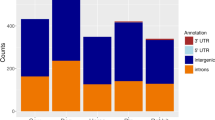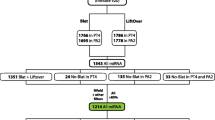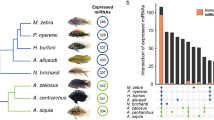Abstract
Despite prior claims to the contrary, several lines of evidence suggest that selection acts on synonymous mutations in mammals. What might be the mechanisms for such selection? Here I attempt to quantify the constraints on the evolution of the coding sequence resulting from regulation of mRNA by microRNAs (miRNAs) that antisense-bind to the coding region of mRNAs. I employ a set of genes recently experimentally verified to be the target of a miRNA, all with putative antisense pairing domains within the coding sequence. Although very small (∼22 nucleotides), 2 of 13 pairing domains show evidence of significantly slow sequence evolution. This, along with evidence that these genes are regulated by the miRNA under consideration, provides the first good candidate domains for intra-CDS pairing of a miRNA in mammals. When analyzed en masse, the putative pairing domains have a significantly reduced rate of synonymous evolution (∼35% lower than null). However, given the size and rarity of pairing domains within the coding sequence, the effects that such constraint has on estimates of the mutation rate are small enough to be ignored (probably less than 1% reduction). The pairing sites also have low Ka values and the selection on the synonymous sites is unlikely to lead to misleading reports of localized high Ka/Ks ratios.
Similar content being viewed by others
References
Bartel DP (2004) MicroRNAs: Genomics, biogenesis, mechanism, and function. Cell 116:281–297
Carlini DB, Genut JE (2006) Synonymous SNPs provide evidence for selective constraint on human exonic splicing enhancers. J Mol Evol 62:89–98
Chamary JV, Hurst LD (2005a) Biased codon usage near intron-exon junctions: Selection on splicing enhancers, splice-site recognition or something else? Trends Genet 21:256–259
Chamary JV, Hurst LD (2005b) Evidence for selection on synonymous mutations affecting stability of mRNA secondary structure in mammals. Genome Biol 6:R75
Chamary J-V, Parmley JL, Hurst LD (2006) Hearing silence: non-neutral evolution at synonymous sites in mammals. Nat Rev Genet 7:98–108
Comeron JM (2004) Selective and mutational patterns associated with gene expression in humans: influences on synonymous composition and intron presence. Genetics 167:1293–1304
Doench JG, Sharp PA (2004) Specificity of microRNA target selection in translational repression. Genes Dev 18:504–511
dos Reis M, Savva R, Wernisch L (2004) Solving the riddle of codon usage preferences: a test for translational selection. Nucleic Acids Res. 32:5036–5044
Duan JB, Wainwright MS, Comeron JM, Saitou N, Sanders AR, Gelernter J, Gejman PV (2003) Synonymous mutations in the human dopamine receptor D2 (DRD2) affect mRNA stability and synthesis of the receptor. Hum Mol Genet 12:205–216
Duret L (2002) Evolution of synonymous codon usage in metazoans. Curr Opin Genet Dev 12:640–649
Edgar RC (2004) MUSCLE: multiple sequence alignment with high accuracy and high throughput. Nucleic Acids Res 32:1792–1797
Eskesen ST, Eskesen FN, Ruvinsky A (2004) Natural selection affects frequencies of AG and GT dinucleotides at the 5′ and 3′ ends of exons. Genetics 167:543–550
Fairbrother WG, Holste D, Burge CB, Sharp PA (2004) Single nucleotide polymorphism–based validation of exonic splicing enhancers. PLoS Biol 2:E268
Farh KK, Grimson A, Jan C, Lewis BP, Johnston WK, Lim LP, Burge CB, Bartel DP (2005) The widespread impact of mammalian MicroRNAs on mRNA repression and evolution. Science 310:1817–1821
Griffiths-Jones S (2004) The microRNA Registry. Nucleic Acids Res 32:D109–D111
Hellmann I, Zollner S, Enard W, Ebersberger I, Nickel B, Paabo S (2003) Selection on human genes as revealed by comparisons to chimpanzee cDNA. Genome Res. 13:831–837
Hurst LD (2002) The Ka/Ks ratio: diagnosing the form of sequence evolution. Trends Genet 18:486–487
Hurst LD, Pal C (2001) Evidence for purifying selection acting on silent sites in BRCA1. Trends Genet 17:62–65
Jackson AL, Bartz SR, Schelter J, Kobayashi SV, Burchard J, Mao M, Li B, Cavet G, Linsley PS (2003) Expression profiling reveals off-target gene regulation by RNAi. Nat Biotech 21:635–637
Keightley PD, Eyre-Walker A (2000) Deleterious mutations and the evolution of sex. Science 290:331–333
Kondrashov AS (1998) Measuring spontaneous deleterious mutation process. Genetica 103:183–197
Kondrashov FA, Ogurtsov AY, Kondrashov AS (2006) Selection in favor of nucleotides G and C diversifies evolution rates and levels of polymorphism at mammalian synonymous sites. J Theor Biol (in press)
Kumar S, Subramanian S (2002) Mutation rates in mammalian genomes. Proc Natl Acad Sci USA 99:803–808
Lavner Y, Kotlar D (2005) Codon bias as a factor in regulating expression via translation rate in the human genome. Gene 345:127–138
Lewis BP, Shih IH, Jones-Rhoades MW, Bartel DP, Burge CB (2003) Prediction of mammalian microRNA targets. Cell 115:787–798
Lewis BP, Burge CB, Bartel DP (2005) Conserved seed pairing, often flanked by adenosines, indicates that thousands of human genes are microRNA targets. Cell 120:15–20
Li W-H (1993) Unbiased estimation of the rates of synonymous and nonsynonymous substitution. J Mol Evol 36:96–99
Lim LP, Lau NC, Garrett-Engele P, Grimson A, Schelter JM, Castle J, Bartel DP, Linsley PS, Johnson JM (2005) Microarray analysis shows that some microRNAs downregulate large numbers of target mRNAs. Nature 433:769–773
Lu J, Wu CL (2005) Weak selection revealed by the whole-genome comparison of the X chromosome and autosomes of human and chimpanzee. Proc Natl Acad Sci USA 102:4063–4067
Nakamoto M, Jin P, O’Donnell WT, Warren ST (2005) Physiological identification of human transcripts translationally regulated by a specific microRNA. Hum Mol Genet 14:3813–3821
Pagani F, Raponi M, Baralle FE (2005) Synonymous mutations in CFTR exon 12 affect splicing and are not neutral in evolution. Proc Natl Acad Sci USA 102:6368–6372
Pamilo P, Bianchi NO (1993) Evolution of the Zfx and Zfy genes: rates and interdependence between the genes. Mol Biol Evol 10:271–281
Parmley JL, Chamary JV, Hurst LD (2006) Evidence for purifying selection against synonymous mutations in mammalian exonic splicing enhancers. Mol Biol Evol 23:301–309
Pond SK, Muse SV (2005) Site-to-site variation of synonymous substitution rates. Mol Biol Evol 22:2375–2385
Robins H, Press WH (2005) Human microRNAs target a functionally distinct population of genes with AT-rich 3 ‘ UTRs. Proc Natl Acad Sci USA 102:15557–15562
Sharp PM, Averof M, Lloyd AT, Matassi G, Peden JF (1995) DNA-sequence evolution: the sounds of silence. Phil Trans R Soc Lond B 349:241–247
Smith NGC, Hurst LD (1999a) The causes of synonymous rate variation in the rodent genome: can substitution rates be used to estimate the sex bias in mutation rate? Genetics 152:661–673
Smith NGC, Hurst LD (1999b) The effect of tandem substitutions on the correlation between synonymous and nonsynonymous rates in rodents. Genetics 153:1395–1402
Tamura K, Kumar S (2002) Evolutionary distance estimation under heterogeneous substitution pattern among lineages. Mol Biol Evol 19:1727–1736
Urrutia AO, Hurst LD (2003) The signature of selection mediated by expression on human genes. Genome Res 13:2260–2264
Willie E, Majewski J (2004) Evidence for codon bias selection at the pre-mRNA level in eukaryotes. Trends Genet 20:534–538
Xie X, Lu J, Kulbokas EJ, Golub TR, Mootha V, Lindblad-Toh K, Lander ES, Kellis M (2005) Systematic discovery of regulatory motifs in human promoters and 3[prime] UTRs by comparison of several mammals. Nature 434:338–345
Yang ZH, Bielawski JP (2000) Statistical methods for detecting molecular adaptation. Trends Ecol Evol 15:496–503
Zhao Y, Samal E, Srivastava D (2005) Serum response factor regulates a muscle-specific microRNA that targets Hand2 during cardiogenesis. Nature 436:214–220
Zuker M (2003) Mfold web server for nucleic acid folding and hybridization prediction. Nucleic Acids Res 31:3406–3415
Acknowledgements
The author would like to thank two anonymous reviewers for constructive comments.
Author information
Authors and Affiliations
Corresponding author
Additional information
[Reviewing Editor: Dr. Manyuan Long]
Electronic Supplementary Material
Rights and permissions
About this article
Cite this article
Hurst, L.D. Preliminary Assessment of the Impact of MicroRNA-Mediated Regulation on Coding Sequence Evolution in Mammals. J Mol Evol 63, 174–182 (2006). https://doi.org/10.1007/s00239-005-0273-2
Received:
Accepted:
Published:
Issue Date:
DOI: https://doi.org/10.1007/s00239-005-0273-2




